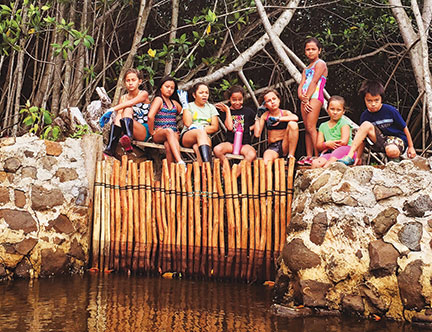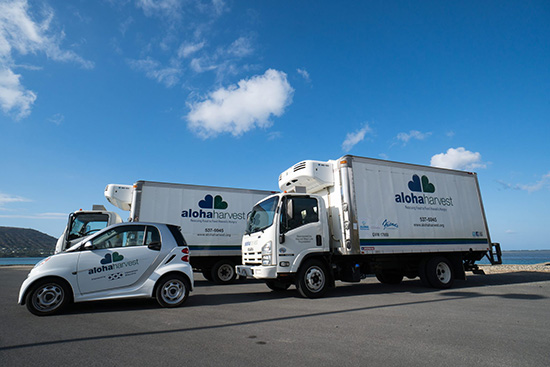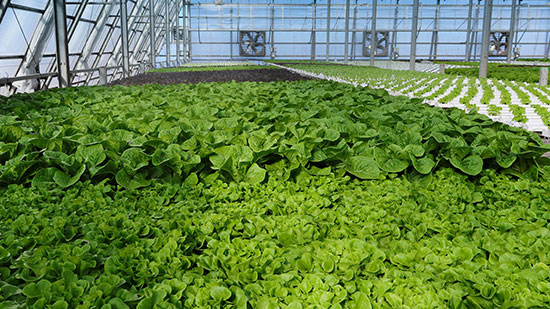
Fifty years ago, a flood destroyed a 200-foot portion of the rock wall of He‘eia fishpond, disabling the ancient pond. Thousands of volunteers are now restoring the fishpond to its former glory.
“After 16 years of hard work, we can prove that the ingenuity of our ancestors really works, and that will create more support,” said Hi‘ilei Kawelo, founder and executive director of Paepae o He‘eia. “The skeptics will see that we are producing fish and will not be as skeptical.”
Hawaiian fishponds are a unique and advanced form of aquaculture that trap baby fish to maturity within a rock wall enclosure and herd the adult fish to shallow tidal areas for harvesting. The invention of the fishpond was a result of Native Hawaiians’ deep connection with the land and the relationship of the food sources on the land to those in the ocean.
“In the early 1900s, it is estimated that He‘eia fishpond could produce enough fish to provide for a population of about 1,600,” said Mahina Paishon-Duarte, Paepae o He‘eia board president and Hālau Kū Māna Charter School principal, in a TedxMānoa speech in October 2012. “The demise of fishponds positively correlates with the decline in natural and cultural landscapes due to the boom of construction.”
It is unknown who commissioned He‘eia fishpond, but stories suggest that it required thousands of committed residents of the ahupua‘a of He‘eia, near Kanē‘ohe, to pass and stack rocks for approximately two to three years to complete the kuapā (wall).
The first recorded owner of the pond is High Chief Abner Paki who was the konohiki (chief) of He‘eia during the mid-1800s. Paki’s daughter, Princess Bernice Pauahi Bishop, inherited the land, which became Bishop Estate and is now owned by Kamehameha Schools.
Between 1988 and 1998, Mark Brooks, the former state aquaculture extension agent, temporarily fixed the kuapā, which had been damaged by the 1969 Keapuka flood, and partnered with the University of Hawai‘i at Mānoa to host the first Mālama Loko Iʻa class, which planted the seed for the restoration organization Paepae o He‘eia.
“The fishpond helped us to reconnect with each other and the place that we live,” said Keli‘i Kotubetey, founder and assistant executive director of Paepae o He‘eia.
Paepae refers to the setting of pohaku (stones) and Paepae o He‘eia signifies the pohaku that was used to build the foundation of the kuapā of He’eia fishpond.
Paepae o He‘eia began with eight friends who were introduced to He‘eia fishpond 18 years ago and saw the potential of He‘eia fishpond.
“There was so much potential that could only be recognized with community support,” Kawelo said.
They began with small restoration projects in 1999 and hosted groups at the fishpond with several UH Mānoa professors to get the community involved. They became a non-profit organization in 2001 and received their first grant from Kamehameha Schools in 2003.
“It was slow going initially, but we started getting traction when Kamehameha Schools started to support us financially,” Kawelo said. “We split the money eight ways as back pay for a year of struggling and quitting our jobs.”
Now they have a staff of 10 dedicated workers and have had 86 interns since 2008.
As of 2015, thousands of volunteers at Paepae o He‘eia have removed mangrove from approximately 4,000 of the 7,000 linear foot kuapā. The Pani Ka Puka initiative, which ran from December 2014 to December 2015, repaired the 200-foot gap in the kuapā. From 2004 to 2012, Paepae o He‘eia removed 50 tons of invasive limu from the fishpond; the limu is now used as fertilizer by Kāko‘o ‘Ōiwi, a non-profit organization based upland of Paepae o He‘eia, in its lo‘i (taro patches).
“We are beginning to see native fish in the pond,” Kawelo said. “It’s very exciting for us because it’s a biological indicator that the fishpond is doing what it’s supposed to be doing, and we get to see the stories of our ancestors come to life.”
While the hole in the wall has been fixed, there is still a lot that needs to be done to get the place completely restored.
This year, Paepae o He‘eia plans to develop and feature various products and services from the fishpond and make them available to the public. In doing so, they aim to mutually benefit the fishpond and those whom it can nourish.
“Fishponds are important places where we as kanaka (Native Hawaiians) can train ourselves to regain our ability and capacity to self-govern,” Paishon-Duarte said.
Many DOE, private and charter schools, as well as Hawai‘i Pacific University and UH Mānoa have made trips to He‘eia fishpond to help Paepae o He‘eia in its restorative projects, while learning about intellectual, physical and spiritual sustenance for the community.
Every year, about 3,000 students visit the fishpond and contribute to the labor force while learning how to take care of the land.
“The fishpond produces something positive in the community that creates a sense of pride and excitement,” Kawelo said.
This semester, students from WCC’s Interdisciplinary 201: The Ahupua‘a course worked with Paepae o He‘eia for four weeks as they examined the traditional Hawaiian approach to natural resource development, utilization, exploitation and management.
“There is so much to learn from the past that you can’t appreciate through technology,” said student Noah Foti.
Paepae o He‘eia hosts workdays for the community every second and fourth Saturday of the month from 8:30 to noon and provides lunch.
“The community is more than welcome to come down and talk story with us and get involved in any way that they can,” Kotubetey said.
For more information, contact Paepae o He‘eia at admin@paepaeoheeia.org or at 236-6178.
by Deborah Higa, Ka ‘Ohana Staff Reporter




